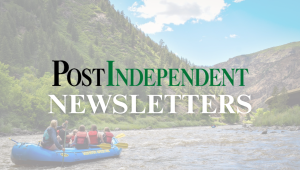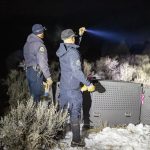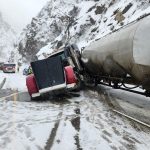Friday Letters: Perspectives on nuclear energy, government workforce, local library leadership and more

The dangers of nuclear energy
Clean nuclear is an oxymoron. Every part of the process is potentially deadly. Mining uranium involves stockpiling mounds of radioactive dirt.
In the National Library of Medicine, the article Health Effects of Particulate Uranium Exposure begins with, “Uranium contamination has become a non-negligible global health problem,” which “can cause severe body damage once inhaled.” The dust billows over reservations and populations near mines.
Yellow cake is produced through milling and roasting. After an intense four-step process, and then shipped to concentrating sites, where the uranium is packed into steel drums and hauled to processing plants to turn it into fuel.
Uranium, like other heavy metals, is toxic and should not be inhaled or ingested, even if mildly radioactive. My trip to Naturita, Colorado, near where it is mined, showed me how potent radioactive dust works to rust the bridges, spall concrete, and ruin folks’ teeth. The milling and roasting into orange oxide at Oak Ridge becomes uranium tetrachloride or S-50 liquid thermal diffusion in the St. Louis plant, then into plutonium piles in Beverly, Massachusetts, or Bloomfield, New Jersey, or Ames, Iowa, where the metal is recast into rods in induction-heated furnaces.
Now it can be shipped to one of the 94 reactors in the United States, where it creates electron-saturated cooling water and spent U-285 rods. The highly contaminated water and nuclear rods pile up over the years and need to be kept from contaminating the environment for thousands of years. So it is encased in concrete and stainless steel, which is stacked on site until it is hauled somewhere for long-term storage, and therein lies the problem.
There is no place to store it safely. Not the salt caverns of WIPP or the deepest subducting zones of the oceans.
Wherever they are stacked, they become a target for an enemy to drop a conventional bomb that will do maximum damage to the downwind population. Yet Chernobyl demonstrated that every place on Earth is downwind, because the atmosphere homogenizes pollutants within three days. Let’s rethink calling “nuclear” clean energy.
John Hoffmann, Carbondale
Upvalley’s lack of housing is not downvalley’s problem
Glenwood Springs “Citizen of the Year” and invisible City Councilman Sumner Shacter is complaining (April 2 letter to the editor in the Post Independent) that two mobile home communities in the Roaring Fork Valley may be sold. Not satisfied with doing nothing while on council in Glenwood Springs besides passing a meaningless anti-Israel/pro-Gaza initiative; Mr. Schater has a new proposal. Buy both parks for $42 million(!) dollars. One thing about our councilman, he loves spending other people’s money.
Forgetting that one park is near Carbondale (only $24 million for that one) and the other is Basalt – Eagle County (only $18 million – a bargain), and outside the councilman’s jurisdiction, where does he expect to raise over forty million dollars? From where? And the better question: Why? Surely $42 million could be better spent to house Aspen’s workforce.
The councilman, who should be dealing with Glenwood’s housing and traffic issues first, says this is a crisis. The true crisis is his lack of leadership and inability to follow election laws and state statutes on his own council, but regardless, despite misguided views this is the free market at work in this valley that he helped create: A community up-valley that can’t house its own workforce, and a community down valley (GWS) that simply won’t without destroying its character.
People in glass houses, or with no “housing,” should attempt to fix their own problems first, not those in Basalt or Eagle, Carbondale or even Khan Yunis.
Tony Hershey, Glenwood Springs
Grateful for our libraries
We are very lucky in Garfield County to have Jamie LaRue as head of our Garfield County Library District. He gave an informative, very interesting presentation on the history of efforts at book banning in the United States Tuesday evening in the Carbondale branch. He explained the very careful procedure our district goes through if a person requests that a book be removed from the shelves. To date, no books have been removed after careful vetting. He made it clear that our libraries exist to serve everyone.
To me, libraries are the bedrock of our democracy. They are free and serve everyone. Knowledge and entertainment are at our fingertips and we can even access books, periodicals, and movies at home using the apps to borrow electronic media. I never thought I would read a book on my phone, but I find that medium useful while traveling.
Our libraries offer speakers, exercise classes, book launches, documentaries, computer access, study rooms, community rooms that all nonprofit groups can use for free, and a kind, helpful staff to help us all find what we want.
Illène Pevec, Carbondale
The truth about the federal workforce
I am writing in response to a letter Congressman Jeff Hurd recently sent to constituents regarding cuts to the federal workforce. In his letter, he said, “…I wholeheartedly agree our federal government has become too big…”
Apparently, Congressman Hurd agrees with President Trump and Co-President Elon Musk that the current civilian federal workforce of approximately 3 million has grown in recent times and needs to be reduced. The truth is that the civilian federal workforce surpassed 3 million for the first time in 1942 and has consistently remained between 2 – 3 million ever since.
In 1942, when the U.S. had 3.4 million civilian federal workers, our population was 135 million. This is one federal worker for every 40 people.
Today, with a civilian federal workforce of 3 million and a population of 342 million, we have one federal worker for every 114 people. In other words, our population has nearly tripled in the past 80 years yet the size of the civilian federal workforce has stayed constant.
Looks like the federal government has done an incredible job of doing more with less! So, why does Congressman Hurd believe our government has grown too big when it has remained virtually unchanged throughout his lifetime?
This is an incredibly important point because Congressman Hurd’s statement that the federal workforce has become too big is the same justification Elon Musk uses to slash the jobs of federal workers. This statement is dishonest.
Cynthia Wutchiett, Paonia

Support Local Journalism

Support Local Journalism
Readers around Glenwood Springs and Garfield County make the Post Independent’s work possible. Your financial contribution supports our efforts to deliver quality, locally relevant journalism.
Now more than ever, your support is critical to help us keep our community informed about the evolving coronavirus pandemic and the impact it is having locally. Every contribution, however large or small, will make a difference.
Each donation will be used exclusively for the development and creation of increased news coverage.






